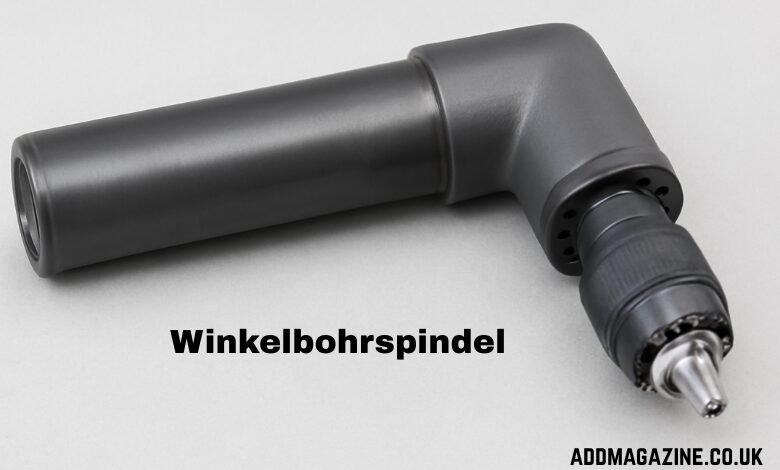In industries requiring precise and efficient machining, tools like the winkelbohrspindel have become indispensable. Known as the “angle drilling spindle” in English, the winkelbohrspindel is specifically designed to perform drilling, milling, and other tasks at precise angles, typically 90 degrees, to the main spindle axis. This ability to operate in tight or restricted spaces makes the winkelbohrspindel essential in sectors such as aerospace, automotive, woodworking, plastics, and metal fabrication. In this article, we will delve deeper into the origin of the winkelbohrspindel, its functionality, its comparison with other tools, and its widespread application across various industries.
What is a Winkelbohrspindel?
A winkelbohrspindel, directly translated as “angle drilling spindle,” is a specialized mechanical device designed to transfer rotational power from a motor to a tool holder at an angle. Typically, this angle is set at 90 degrees, but advanced versions allow for adjustable angles. The spindle is commonly used for drilling, milling, and other machining tasks when direct access to a workpiece is not possible, or when an angled cut or hole is needed.
The precision gears in a winkelbohrspindel, typically bevel or hypoid gears, transfer power efficiently from the motor to the output tool holder. This mechanism reduces energy loss, maintains torque, and ensures consistent cutting performance. The spindle is an essential tool for both CNC machines and manual setups that require angled drilling or milling.
The Origin of Winkelbohrspindel: Where Did It Come From?
The winkelbohrspindel has its roots in German engineering, where precision and accuracy in mechanical devices are highly valued. The term “winkelbohrspindel” comes from the German words “Winkel” meaning angle, and “Bohrspindel” meaning drilling spindle. Over time, as industries like automotive manufacturing, aerospace, and metal fabrication demanded more complex operations, the need for a device capable of angled drilling and milling became evident. This led to the development of the winkelbohrspindel, which was designed to offer precision where conventional spindles fell short.
The spindle’s ability to perform precise machining tasks in difficult-to-reach areas revolutionized how parts and components were manufactured, especially in industries dealing with intricate designs and strict tolerance requirements. Over the decades, as industries evolved and technology advanced, the winkelbohrspindel’s design also underwent various modifications, incorporating adjustable angles, high-speed capabilities, and heavy-duty construction to meet increasingly demanding tasks.
Types of Winkelbohrspindel
Winkelbohrspindels come in various configurations, each suited to different needs and applications. Understanding these options can help manufacturers select the right tool for their specific requirements.
- Fixed Angle Winkelbohrspindels: These models are typically set at a 90-degree angle, which is ideal for many standard drilling and milling operations. While they are less versatile than adjustable versions, fixed-angle spindles offer high precision and are sufficient for many applications in CNC machines and manual setups.
- Adjustable Angle Winkelbohrspindels: For more complex operations that require flexibility, adjustable winkelbohrspindels are an excellent choice. These spindles allow for varying the angle of the tool holder, providing versatility for a range of applications. This feature is particularly useful in CNC machining centers, where operators may need to switch between different angles quickly and efficiently.
- High-Speed Winkelbohrspindels: Some winkelbohrspindels are designed to operate at higher speeds, making them suitable for tasks that require fast, high-precision machining. These high-speed models are commonly used in industries such as automotive and aerospace, where large-scale production often necessitates fast turnarounds without sacrificing quality.
- Heavy-Duty Winkelbohrspindels: Built for tougher applications, heavy-duty winkelbohrspindels can handle more substantial forces and are ideal for industries working with tough materials such as metals, composites, and plastics. These models are designed to maintain performance even under challenging conditions, ensuring that the integrity of the machining process is upheld.
Winkelbohrspindel vs Other Tools: Key Differences
While the winkelbohrspindel excels in its specialized function of performing angled machining, it’s essential to compare it with other common tools used in similar applications, such as traditional spindles, angle drills, and flexible shafts. Each of these tools has its own set of advantages and limitations depending on the requirements of the task.
- Winkelbohrspindel vs. Traditional Spindles:
- Traditional spindles operate along a single axis, making them ideal for tasks where perpendicular drilling or milling is required. However, they fall short when the workpiece is in a position that doesn’t allow direct access for drilling at an angle.
- The winkelbohrspindel, on the other hand, is engineered to handle angular operations, such as drilling holes at 90 degrees to the main spindle axis or other adjustable angles. This capability allows the winkelbohrspindel to perform tasks in confined or hard-to-reach spaces where traditional spindles cannot operate effectively.
- Winkelbohrspindel vs. Angle Drills:
- Angle drills are commonly used for tasks requiring drilling at specific angles, typically up to 90 degrees. However, angle drills often lack the precision and power transmission capabilities of a winkelbohrspindel.
- The winkelbohrspindel offers greater torque and precision, making it suitable for CNC machines or highly intricate tasks in aerospace, automotive, and metal fabrication. Additionally, winkelbohrspindels are often built with more durable materials and advanced gearing mechanisms, making them capable of handling tougher machining jobs.
- Winkelbohrspindel vs. Flexible Shafts:
- Flexible shafts are used in many applications requiring a high degree of flexibility and reach. While they are ideal for tight spaces, they lack the rigidity and precision offered by the winkelbohrspindel.
- Winkelbohrspindels are designed for more demanding tasks, providing both flexibility and precision. They are often preferred for CNC setups or applications where accuracy is paramount.
Key Features of Winkelbohrspindel
Several distinguishing features set the winkelbohrspindel apart from other tools, making it a vital addition to many industries.
- Precision Gear Mechanism: The bevel or hypoid gears used in winkelbohrspindels ensure efficient power transfer, reducing energy loss and maintaining torque for consistent cutting performance. This mechanism is particularly important in industries where precise, repeatable results are required.
- Angle Adjustment: Many winkelbohrspindels allow for angle adjustment, providing greater flexibility in machining. Adjustable-angle models are essential when a range of angles is needed for various tasks, such as in prototyping or custom manufacturing.
- Durability and Compact Design: Winkelbohrspindels are designed to operate in harsh environments. They are compact and durable, often built from high-quality materials to withstand continuous operation while maintaining precision. Their small size allows them to be used in tight or hard-to-reach spaces, making them a versatile tool in complex machining operations.
- High-Speed Performance: Some winkelbohrspindels are designed for high-speed operations, enabling manufacturers to perform drilling or milling tasks faster while maintaining the required precision.
- Versatility: Winkelbohrspindels are widely used in CNC machining centers, manual setups, and specialized equipment. Whether fixed at 90 degrees or adjustable, they offer the flexibility required for a wide range of machining tasks.
Applications of Winkelbohrspindel
The winkelbohrspindel finds application across a broad range of industries due to its ability to perform precise, angled machining tasks:
- Aerospace: The aerospace industry relies on winkelbohrspindels to manufacture parts with exact specifications, such as turbine blades, fuselage sections, and landing gear components. The ability to drill and mill at precise angles is essential for meeting the strict tolerance standards required in aerospace manufacturing.
- Automotive: Automotive manufacturers use winkelbohrspindels for producing high-precision engine parts, transmission components, and suspension systems. The ability to perform angled cuts on tough materials ensures that each part meets performance standards.
- Metal Fabrication: Winkelbohrspindels are used in the metal fabrication industry for drilling and milling metal parts that require angled cuts. Their ability to work in confined spaces makes them ideal for this sector, where access to the workpiece can often be limited.
- Woodworking and Plastics: In woodworking and plastic fabrication, winkelbohrspindels allow for precise drilling and milling of parts used in furniture making, product prototypes, and industrial products. The ability to work at angles helps create smooth, accurate fits between parts.
- Custom Manufacturing: Winkelbohrspindels are also used in small-scale and custom manufacturing, where specialized parts need to be produced with high precision. Their ability to perform complex angled machining tasks in tight spaces makes them an invaluable tool for custom projects.
Why Winkelbohrspindel?
The winkelbohrspindel was developed to address a growing need for precision in complex manufacturing processes. Its design enables manufacturers to achieve angles and precision that would otherwise be difficult or impossible with traditional spindles or drills. The ability to perform machining tasks in tight spaces, while maintaining torque and power efficiency, makes the winkelbohrspindel a critical tool in modern industrial operations.
Maintenance and Longevity
Maintaining a winkelbohrspindel is crucial for ensuring its long-term performance. Regular maintenance checks should include:
- Lubrication: Ensuring that the gear mechanism is properly lubricated helps reduce friction and wear on the moving parts of the spindle, increasing its lifespan and efficiency.
- Inspection of Precision Gears: Over time, the bevel or hypoid gears may wear down, leading to a decrease in cutting precision. Regular inspection and timely replacement of gears are essential for maintaining the spindle’s performance.
- Checking for Alignment Issues: As with any machine tool, it’s important to periodically check the alignment of the winkelbohrspindel. Misalignment can lead to poor machining results and damage to both the spindle and the workpiece.
- Tool Holder Maintenance: The tool holder is a critical component of the winkelbohrspindel. Regular cleaning and checking for wear ensure that the holder maintains a secure fit and optimal cutting performance.
Conclusion
The winkelbohrspindel is an essential tool in industries where precision, accuracy, and access to hard-to-reach areas are critical. Whether performing angled drilling or milling, this specialized spindle outperforms traditional tools, offering greater torque, flexibility, and precision. Originating from German engineering, the winkelbohrspindel has become a staple in sectors such as aerospace, automotive, metal fabrication, and woodworking.
When compared to other tools like traditional spindles, angle drills, and flexible shafts, the winkelbohrspindel offers superior performance in complex, angled machining tasks. Its high-speed capabilities, compact design, and adaptability make it an indispensable part of any modern machining operation.
By understanding the key differences between the winkelbohrspindel and other tools, manufacturers can make informed decisions about which tool to use for specific tasks. With its continued development and applications in various industries, the winkelbohrspindel will remain a critical tool for achieving high precision and efficiency in machining operations for years to come.




